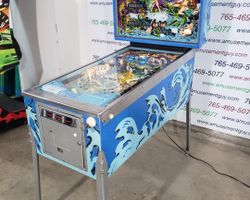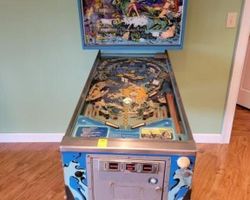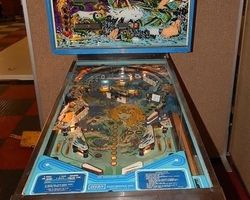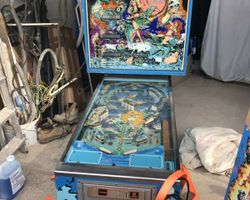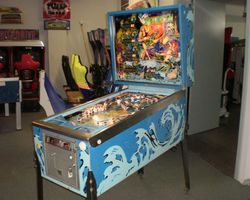Seawitch
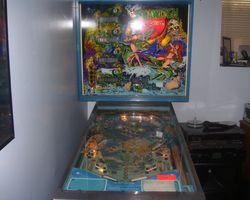
Average Prices: USD $300 to $3,000
Produced: May, 1980
Production Run: 2,503 units
Machine Type: Solid State Electronic
MPU: Stern M-200 MPU
Players: 4
Design by: Mike Kubin
Art by: Bob Timm
Software by: Bill Pfutzenreuter
"Seawitch," a solid-state electronic pinball machine from Stern Electronics, Incorporated, emerged in May 1980 as a distinctive entry in the era's competitive landscape. Designed by Mike Kubin, with art by Bob Timm and software by Bill Pfutzenreuter, this machine quickly carved out its identity. Its theme delves into a vibrant aquatic fantasy, featuring a powerful enchantress of the deep, mystical sea creatures, and underwater realms. The design and production process focused on creating an engaging player experience, marrying mechanical ingenuity with captivating visuals. A total of 2,503 units were produced during its manufacturing run, which spanned from early May to mid-June of 1980, marking a substantial presence for Stern Electronics at the time. A curious detail from its production involves variations in cabinet art; some machines featured a "brick wall" design on the cabinet bottom, a departure from the main artwork, which appeared on a limited number of units. The artistic vision extended beyond the playfield and backglass, which Bob Timm meticulously crafted, encompassing a cohesive thematic experience for players.
Signature Features and Design
"Seawitch" stands out due to several defining elements that contribute to its distinctive gameplay. Foremost among these are its four flippers, a configuration that offers expanded shot angles and control, particularly crucial for navigating its fast-paced playfield. The machine incorporates three pop bumpers, strategically placed to create lively ball action and unpredictable ricochets. Two slingshots further enhance the chaotic, yet controlled, ball movement. Integral to the scoring mechanics are the numerous targets: four standup targets and a total of eleven drop targets, arranged in two 4-bank sets and one 3-bank set. These drop targets are not merely obstacles but core objectives, resetting to create repetitive scoring opportunities and demanding precision. A spinning target and two star rollovers add variety to the scoring paths. The backglass and playfield art, executed by Bob Timm, present a unique "comic book" style, characterized by bold lines and vivid colors, depicting the "Seawitch" herself surrounded by sea serpents and intricate underwater imagery. This aesthetic package, combined with atmospheric sound effects, including a memorable "crashing waves" background sound, immerses the player in the aquatic theme.
Playfield and Mechanics
The playfield layout of "Seawitch" is meticulously designed to foster a quick and flowing game. At the bottom, the four flippers are configured to allow for diverse shot opportunities. Two lower flippers handle primary play, while two additional flippers, positioned higher on the playfield, provide access to otherwise unreachable targets and crucial pathways. The central feature often cited for its challenge and reward is the "Rip Tide" loop shot, an orbit that, when repeatedly made, can rapidly escalate scores. This shot requires precise timing and power, often leading to a satisfying sense of accomplishment when successfully chained.
The three banks of drop targets are strategically positioned across the playfield. One 3-bank is often found centrally, while the two 4-bank sets are arrayed to challenge players from different angles. Knocking down these targets is fundamental to building bonus multipliers and advancing game objectives. The artwork on the playfield integrates seamlessly with the overall theme, featuring detailed illustrations of corals, underwater ruins, and sea creatures that guide the eye towards key targets and pathways. The lighting system, while characteristic of early solid-state machines, effectively highlights scoring elements and emphasizes the mystical underwater ambiance. The flow of the playfield encourages players to keep the ball in motion, moving from target banks to the challenging loop shot, creating a continuous and engaging experience.
Gameplay Dynamics
"Seawitch" offers a direct, yet engaging, gameplay experience, firmly establishing itself as a "shooter's game." The primary objective revolves around systematically clearing the three banks of drop targets. Each completed bank contributes to bonus multipliers, which are awarded at the end of a ball. This core mechanic drives much of the player's strategy, encouraging precision and target-oriented play. The game's scoring system is straightforward but allows for significant point accumulation through strategic target clearing and repeated successful shots on the "Rip Tide" loop.
Unique to "Seawitch" is its emphasis on speed. The ball moves across the playfield at a remarkable pace, demanding quick reflexes and constant control from the player. The four flippers are instrumental in managing this velocity, allowing for critical saves and precise shot setups. While "Seawitch" predates the complex multi-mode structures of later machines, its challenge lies in the execution of its core elements. Players must master the difficult loop shot, which, despite its challenge, provides immense satisfaction and significant scoring potential when achieved. The spinning target and standup targets provide additional opportunities for points and contribute to the overall flow of the game. Maintaining control amidst the rapid action, strategically clearing drop targets, and aiming for the high-scoring loop define the memorable highlights of playing "Seawitch."
Reception and Legacy
"Seawitch" has consistently garnered a positive reception within the pinball community, often celebrated as a prime example of an early Stern Electronics machine that retains its appeal. Its most frequently lauded attribute is its speed; players universally describe it as a very fast-paced game, often exceeding the velocity of other machines from its era, leading to an almost non-stop action experience. This speed, combined with its excellent playfield flow, allows for smooth shot transitions and a highly addictive quality that encourages continuous play. The three banks of drop targets are a central element of its appeal, providing clear objectives and satisfying feedback when cleared. The "Rip Tide" loop shot, while frequently noted for its difficulty, is also recognized as a deeply satisfying shot when executed, contributing significantly to high scores and the game's overall challenge.
The artwork package, encompassing the backglass, playfield, and cabinet, is widely praised for its unique "comic book" style, vibrant colors, and effective integration of the aquatic fantasy theme. This visual appeal, alongside the atmospheric "crashing waves" sound effect, creates an immersive experience. From a mechanical standpoint, the inclusion of four flippers is a distinctive feature, enhancing control and expanding shot opportunities. Despite its relative simplicity compared to modern machines, "Seawitch" is considered to possess ample depth and challenge, often described as a "shooter's game" with a clear path to high scores. While a few critiques mention the upper flipper placement causing awkward bounces or the difficulty of the loop shot being excessive, these points are generally outweighed by the positive sentiment. Concerns about older machines, such as potential insert wear causing blue inserts to lose their color, are also occasionally noted.
"Seawitch" maintains a strong reputation as a classic from the early 1980s. Its influence lies in its successful execution of fundamental pinball elements—speed, flow, and satisfying shot mechanics—without relying on overly complex rulesets. It stands as a testament to the design philosophy of its era, demonstrating that engaging gameplay can be achieved through precise layout and challenging, yet rewarding, shot design. Its enduring popularity among collectors and enthusiasts underscores its significance as a well-regarded and enjoyable solid-state pinball machine.
Sponsored Links
 Ebay Listings
Ebay Listings
 Auction Results
Auction Results
| Cost | Location | Date |
|---|---|---|
| USD $3,400 |  Delaware, United States Delaware, United States |
07 November, 2025 |
| USD $3,975 |  Indiana, United States Indiana, United States |
08 April, 2025 |
| USD $4,300 |  Pennsylvania, United States Pennsylvania, United States |
08 March, 2025 |
| USD $950 |  Tennessee, United States Tennessee, United States |
09 January, 2025 |
| USD $1,850 |  Idaho, United States Idaho, United States |
21 November, 2024 |
| USD $3,550 |  Maryland, United States Maryland, United States |
27 May, 2024 |
| USD $6,975 |  Maryland, United States Maryland, United States |
19 February, 2024 |
| USD $3,250 |  Massachusetts, United States Massachusetts, United States |
25 March, 2023 |
| USD $3,500 |  Minnesota, United States Minnesota, United States |
24 October, 2022 |
| USD $3,000 |  Florida, United States Florida, United States |
22 December, 2021 |


Private Policy · Search Website · Contact Us
As an eBay Partner, we may earn a commission from qualifying purchases made through links on this site, at no additional cost to you.
All trademarks and copyrighted materials remain property of their respective owners. All other content copyright 2007 - 2025 Pinpedia.


